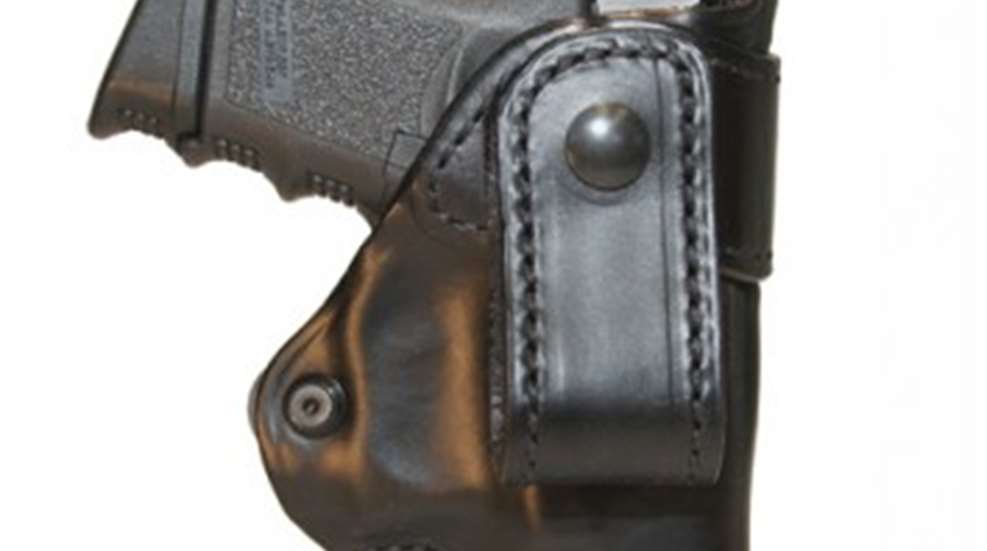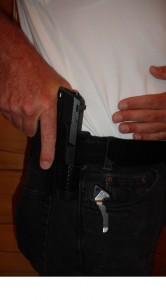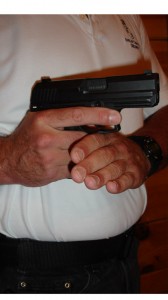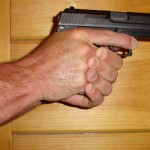
It's only fair for me to start this month's installment by setting the record straight. In Holsters Part I,I wrote, "Why take the chance of inadvertently muzzling yourself while re-holstering with a pancake style holster?" I should have stressed that I meant soft nylonpancake holsters, the kind that lie completely flat against your hip and require you to open the mouth of the holster to insert the gun. I am currently trying out a few pancake holsters offered by different manufacturers, and so far I am very surprised and happy with what I have used. So thank you for your comments and I'll let you know my findings.
Now back to the task at hand. One important choice we must make is not only the style of holster we choose, but the material used to build the holster. We'll start withleather, which certainly is the most traditional material used to date and the most forgiving on firearm finish. These holsters can be purchased in just about any price range. From form-fitted, exotic reptile skin to loose, open-mouthed cowhide versions and everything in between, the choice is up to you.
A good leather holster will require some maintenance, which may be as minor as applying waterproofing or leather conditioner. It all depends on where you call home—a dry or a damp climate. The uses of these products help keep your leather holster waterproof (free of mold or mildew), soft and supple (less likely to dry out and crack). One may also find that a new leather holster can be very tight on the gun. This is a very simple problem to fix. I break in my new leather holsters by placing a plastic Ziploc-type bag over my unloaded pistol and seat it all the way in the new holster. Then, I leave it that way for about 24 hours. When I remove the gun from the bag, it fits perfectly in the holster. The biggest drawback to leather is it can retain moisture, especially if for inside-the-waistband type holsters on hot summer days, which could lead to rust on your shooting iron.
Next we have Kydex,which is a type of polymer and is the most widely used type of holster material on the market today after leather. Although harder on the gun's finish than leather, the level of protection is much greater in the case of an accidental fall or hard strike to the holster itself. These types of holsters are my first choice for a few good reasons. First, your gun "clicks" into place, making this holster very secure. Second, Kydex holsters do not retain moisture. Last, re-holstering with most Kydex models is very easy. It doesn't hurt to mention that Kydex holsters are a breeze to clean, and most are adjustable for fit and level of retention. But, buyer beware—the cheaper models have rivets that can come apart and damage your pistol's finish, and snag on or tear clothes.
So that leaves nylon. The only really good thing that comes to mind is nylon is cheap. Remember, you get what you pay for. I guess in a tight spot, I might use a nylon holster, but that's about the only case. I'm not referring to Kydex holsters with a nylon shell; I mean an all-nylon holster—the type that will start to fray and come apart with little to no use. I don't like them and never will.
Last, but not least, are some considerations as to what type of belt you want to wear. Choose one that's not too small for the holster. Most dress belts will be too thin and won't keep your holster firmly seated in the correct place. On the other hand, some leather or nylon belts may be too wide or thick. Check before you buy. Same goes for a magazine pouch. As an aside, I like my holster and mag pouches to match, and I'd expect most folks agree. Does it matter for practicality? Nope. Does it look nice? Yes.
Now gear up. Most people will find it best to start with a strong-side holster, but use whatever holster works with your primary mode of carry. For simplicity's sake, I'll continue with a strong-side, outside-the-belt holster in mind.
It's important to make sure a holster that rides on your belt is firmly positioned. Seat the holster by weaving your belt from under the belt loop of your pants, through the first loop of the holster, then through the next pants belt loop and finally through the second loop of the holster. This keeps the holster secure. If you're using a single-loop holster, place it between the belt loops on your pants. For a paddle holster, make sure the paddle is seated either between the body and pants or the belt and pants, and ensure the paddle ridges are lower than the belt. This not only seats it properly, it also makes sure it stays in place when performing the draw.
Take some time to get used to the weight of the gun in your holster. Walk around a dedicated room in your house while wearing it. Remember, just like with your dry-fire practice, you need a specific area or room in your home without any ammo present to practice holstering and re-holstering.

Practice everything we have learned thus far. First, square yourself, facing your target. Seat your grip as discussed. Your shooting grip is actually established on the gun while it's in the holster (right).

Then, move your hands simultaneously when drawing your gun. Your weak hand will be flat, with fingers together and resting on your abdomen. The pinky finger should be level with the top of the holster. With your finger off the trigger and your grip seated, lift your firearm straight up to clear the holster, then rotate the muzzle upward 90 degrees, pointing the muzzle at your intended target (left). Immediately mold the fingers of your support hand over the strong.

Finally, extend the firearm while using the sights to interrupt your line of vision and engage your target (right).
When re-holstering, you will simply perform your draw in reverse. Maintain eye contact with your intended target while bringing your hands back to the ready position [close to the body, muzzle of the gun held level and still pointed at the target]. Next, separate your hands simultaneously; the support hand is placed back on the abdomen as you rotate the 90 degrees, back down and into the holster. Be sure not to look the gun back into the holster and keep your finger off the trigger. If your gun has a manual safety or de-cocking lever, these should be employed before going back to the holster.
As NRA Headquarters Range Manager Greg Wodack loves to say, "You get to practice holstering twice, once coming out of the holster and then going back in."





































